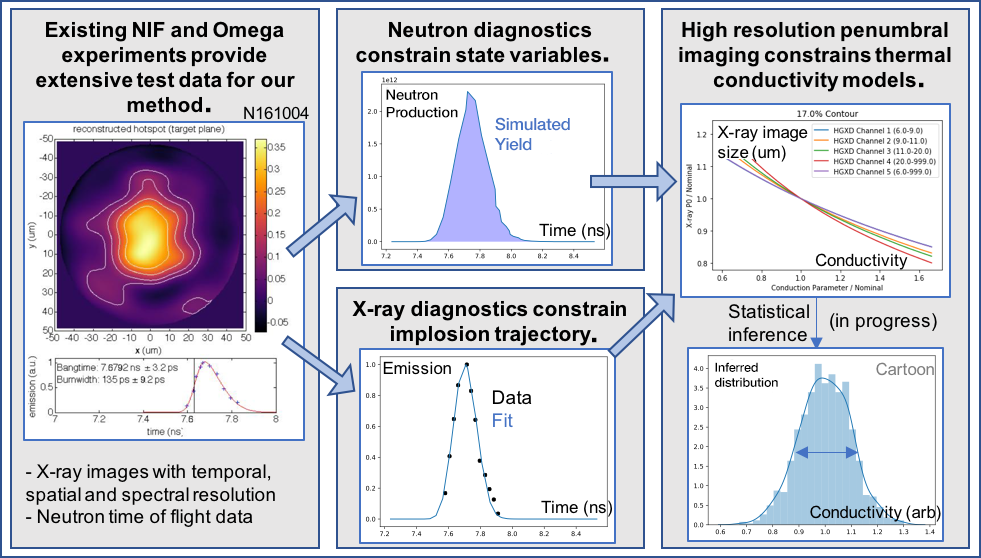Yuan Ping (17-FS-031)
Executive Summary
In this investigation of plasma transport property effects, we intend to explore the feasibility of a novel method to measure thermal conductivity in high-energy-density matter created by convergent compression to reach extreme densities and temperatures. The technique we are exploring is relevant to studying high-energy-density physics at extreme conditions, as well as for stockpile stewardship science and Inertial Confinement Fusion research.
Project Description
Thermal conductivity is one of the most crucial physical properties of matter for understanding heat transport, hydrodynamic evolution, and energy balance in systems ranging from astrophysical objects to fusion plasma. A fundamental property of matter, thermal conductivity is a necessary input in every hydrodynamic code. It plays a key role in determining instability growth rate at material interfaces and energy balance in Inertial Confinement Fusion implosions as well as the thermal convection rate inside the Sun’s convection zone. Yet experimental data are scarce in the high-energy-density regime, leaving theoretical models untested and unvalidated for matter subjected to extreme temperature and pressure. We successfully measured thermal conductivity of aluminum and other materials for the first time in warm dense matter regime in planar geometry. However, to reach higher temperatures, densities, and pressures, a convergent geometry becomes necessary. We are exploring the feasibility of a novel method to measure thermal conductivity in high-energy-density matter created by convergent compression to reach extreme densities and temperatures. The radial profile of a hot spot is sensitive to thermal conductivity as a result of thermal conduction loss along the strong gradient. This measurement is enabled by the recently developed penumbral imaging technique, which provides the required spatial resolution. Preliminary simulations have indicated the feasibility of such measurements.
Measuring thermal conductivity experimentally is challenging because thermal conduction only occurs in the presence of a thermal gradient that is usually difficult to control. However, it is well known that imploding shells create a thermally dominated temperature profile, with a spatial shape that is strongly dependent on the thermal conductivity. In our project, we are determining the feasibility of using a platform for thermal conductivity measurements at temperatures greater than 1 keV and densities greater than 10 g/cm3, and, if successful, providing the first data for benchmarking various models. We are designing and performing two experiments, one on the National Ignition Facility using indirect drive (in which lasers heat the inner walls of a gold cavity containing a target fuel capsule, creating a super-hot plasma that radiates a uniform “bath” of soft x-rays and implodes the fuel capsule) and one on the OMEGA laser facility at the Laboratory for Laser Energetics, New York, using direct drive (in which laser light focuses directly on the target fuel capsule). Our method is applicable to many materials, such as Inertial Confinement Fusion fuel and ablator materials including deuterium–tritium, carbon–hydrogen, and beryllium. We are refining the laser target design to maximize the sensitivity to thermal conduction and minimize the effects of other processes. For example, hydrodynamic instabilities at interfaces can be minimized by choosing single-material targets, and radiation effects can be mitigated by performing measurements at x-ray energies where the hot spot is optically thin. The data we expect to obtain are critical for understanding the uncertainties in models used in computer design codes under these extreme conditions, which is part of the predictive capabilities important for high-energy-density research into both Inertial Confinement Fusion and stockpile stewardship science.
Mission Relevance
Our project to examine the feasibility of a technique to obtain thermal conductivity measurements under extreme conditions of temperature and pressure supports the NNSA goal of advancing the science, technology, and engineering competencies that are the foundation of the NNSA mission, and also supports Lawrence Livermore’s high-energy-density science core competency.
FY17 Accomplishments and Results
In FY17 we submitted a basic science proposal to request OMEGA laser time for our experiment in FY18. In addition, we performed analysis and simulations for the experimental design (see figure).
We are using existing data sets as a proof of principle for our proposed thermal conductivity measurements prior to actual experiments on the National Ignition Facility (NIF) and the OMEGA laser facility. A combination of time- and space-resolved x-ray data with neutron data can constrain an energy-balance model for the hot-spot-state variables during a NIF implosion. The addition of high-resolution penumbral images then constrains the thermal profile in the hot spot and therefore the thermal conductivity. We have demonstrated this analysis procedure for the first time using data from a layered NIF implosion. This approach will be used to generate detailed experimental designs for upcoming ride-along shots on NIF and OMEGA, with the aim of measuring the thermal conductivity of hydrogen at the most extreme temperatures and pressures that can be accessed in the laboratory.
   





